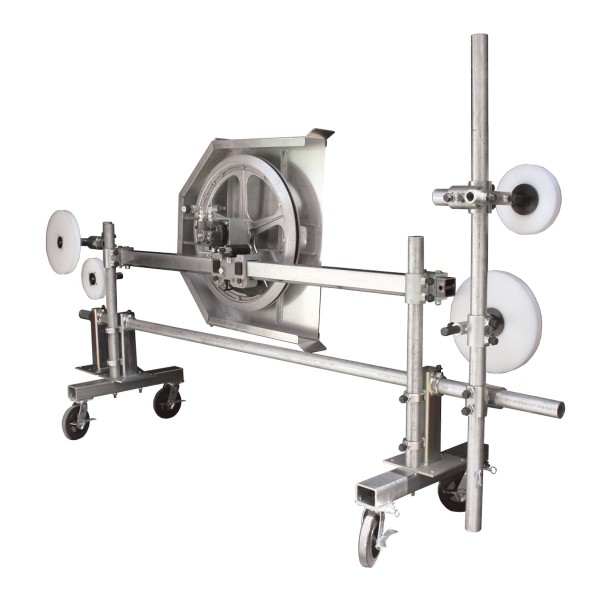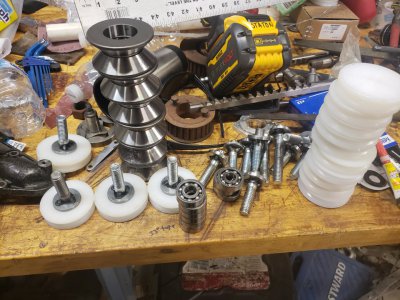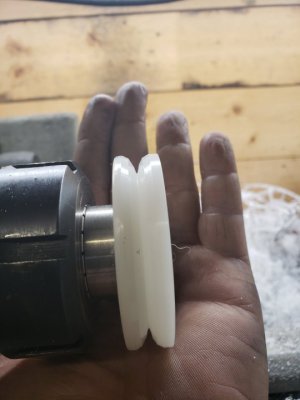-
Welcome back Guest! Did you know you can mentor other members here at H-M? If not, please check out our Relaunch of Hobby Machinist Mentoring Program!
You are using an out of date browser. It may not display this or other websites correctly.
You should upgrade or use an alternative browser.
You should upgrade or use an alternative browser.
DIY wire saw designed to slice up a forklift
- Thread starter strantor
- Start date
- Joined
- Feb 1, 2015
- Messages
- 9,597
EDM wire is available in .012" diameter. My understanding is that it is only used for a single pass and then scrapped. You might check wirh some local shops about relieve them of some of their scrap.
- Joined
- Oct 29, 2012
- Messages
- 1,328
That's something I hadn't thought of. Thanks for the suggestion!EDM wire is available in .012" diameter. My understanding is that it is only used for a single pass and then scrapped. You might check wirh some local shops about relieve them of some of their scrap.
- Joined
- Nov 25, 2015
- Messages
- 8,271
what kinds of pulleys are you going to use that the diamond wire won't cut thru?
- Joined
- Oct 29, 2012
- Messages
- 1,328
UHMW Polyethylene. I machined a very narrow groove into them so that the wire sort of "pinches" in the groove, getting as much traction as possible. As long as there is no relative motion between the wire and the pulley contact surface, there is no problem. It's when the wire slips on the pulley that things go downhill fast. Offshore we used a medium durometer rubber liner in an aluminum pulley, and I think that's optimal, but I don't really have the luxury of time to make something like that. UHMW is the most abrasion-resistant thing I have at the time.what kinds of pulleys are you going to use that the diamond wire won't cut thru?
Attachments
- Joined
- Nov 25, 2015
- Messages
- 8,271
I am thinking the UMHW will cut through. I think the rubber coated (anything) doesn't allow the diamond to cut, it just provides a soft cushion that gives, and therefore the diamond doesn't sink in, the rubber acts like little fingers grabbing the diamond wheel and following it thereby rotating.UHMW Polyethylene. I machined a very narrow groove into them so that the wire sort of "pinches" in the groove, getting as much traction as possible. As long as there is no relative motion between the wire and the pulley contact surface, there is no problem. It's when the wire slips on the pulley that things go downhill fast. Offshore we used a medium durometer rubber liner in an aluminum pulley, and I think that's optimal, but I don't really have the luxury of time to make something like that. UHMW is the most abrasion-resistant thing I have at the time.
I think the best thing you can do is try to mimick that. Even with plasti dip, it might work.
So if you find the UMHW cutting, try coating any pulley with plasti dip (multiple coatings) and see if that helps. I watched them cut granite with the diamond wire. pretty cool.. they used coolant, and pulled the wire through in a circular loop.
- Joined
- Oct 29, 2012
- Messages
- 1,328
Hey, that's a great idea. Thanks for the recommendation!I am thinking the UMHW will cut through. I think the rubber coated (anything) doesn't allow the diamond to cut, it just provides a soft cushion that gives, and therefore the diamond doesn't sink in, the rubber acts like little fingers grabbing the diamond wheel and following it thereby rotating.
I think the best thing you can do is try to mimick that. Even with plasti dip, it might work.
So if you find the UMHW cutting, try coating any pulley with plasti dip (multiple coatings) and see if that helps. I watched them cut granite with the diamond wire. pretty cool.. they used coolant, and pulled the wire through in a circular loop.
I can at least confirm that it is not an instant failure kind of situation, as I have ran it probably a total of 5 minutes so far with the diamond wire on the UHMW, and there was no visible damage to the pulleys yet. So I have hope that they will work as-is, but I am expecting the cut will take a few hours and that's quite a different story than 5 minutes. If they don't work out over the long haul I'll try the plasti-dip. If that doesn't work I guess I'll need to machine a mould and do some research on castable rubber compounds.
FWIW at my previous employer we also had one of those granite quarry style wire saws that we used for testing different techniques, and it had a variety of different pulleys you could use. Some of them were just straight up slabs of UHMW cut into a pulley shape, pretty much like I did, except they had a semicurcular profile where I used a sharp V. ex:

- Joined
- Nov 25, 2015
- Messages
- 8,271
BTW I don't think plasti dip will stick to UMHW, but it's worth a try, that stuff is so slippery, I use it for glide surfaces.
- Joined
- Nov 25, 2015
- Messages
- 8,271
do you have to reverse? is there no way to braid the line together like they do for eye's on big steel cables, and on ships lines? where you open the wire and braid it together. I know it will be thicker, but how do they do it for the professional machines?Have you ever wished you had a nice foot-thick cube of cast iron from which you could machine, say, an entire new lathe headstock? Or a 2ft long 4"x6" slab from which to machine a new cross slide? Or enough of it in convenient shapes that you could use to build up an entire CNC machine? If you have, then you probably found, like I did, that cast iron typically comes cast in shapes that were convenient for whoever cast them and what they were trying to make, and not so much for you to and what you're trying to make. You probably found out that lifting weights are junk iron, tractor ballast weights are made of gold, and durabar is actually made of platinum. You've probably watched a few casting videos, so you know it can be done, but it seems like a P.I.T.A. and there's nothing new or spectacular about it. If you're like me, then you have a junk forklift sitting in your driveway (that the scrap yard won't take because it's beyond their ability to scrap), and every day you walk by it and it flaunts its big beautiful cast counterweight hips at you, daring you to find a way to cut through a foot thick of cast iron. Well, I think I might have found it.
This particular janky P.O.S. happens to be a diamond wire saw.
View attachment 392665
Yes, it's made entirely out of unistrut. Yes, it's janky as hell. It's prototype, ya know, "for testing purposes only." If it works as well as I hope, I'll make something more permanent. Maybe out of welded square tube. Or not.
I know some things about diamond wire cutting as I used to work with subsea diamond wire saws similar to this:
But this one is different. Those offshore ones use a continuous loop wire rope with sintered diamond beads, about 12mm OD. This one uses single-strand wire surplus from the semiconductor industry (used to slice silicon ingots with very little kerf) and has about 0.3mm OD. It is something like a "portable" version of this:
I won't be able to join the ends of 0.3mm steel wire without leaving some kind of knot that would get hung up in the cut, so I won't be able to do it like I used to offshore. I don't know for sure, but from what I've been able to find online, it seems they have it on spools with several miles of wire and I think they wind it off a full spool, through the cut, onto an empty spool, and swap the spools once all the wire has passed through. They can the run the same wire several times before it no longer makes cuts that pass their muster.
My saw is like a hybrid between the two concepts. It's laid out like a subsea saw, but has a single bobbin wound with 1000+ ft of wire. The bobbin spins one way, paying out wire from one end, going out around a system of pulleys like the subsea saw, then wound back onto the same bobbin. It runs until all 1000ft of wire has been moved from one end of the bobbin to the other, then it stops, reverses direction, and runs 1000ft the other way, then stop, repeat.
Here's a video I shot last week. It should help illustrate how it works and provide context for the video that follows it.
After I'm done cutting through the forklift I'll either hang it from the ceiling in my shop as some kind of haphazard guillotine saw, or transform it into something more permanent like a large bandsaw.
Here's an update to the previous video that I just uploaded tonight:
And below is an early attempt at balancing the drum. This thing will be spinning 2700 RPM so it needs to be at least somewhat balanced. I am going to revisit the balancing now that I have the saw mounted in a more substantial frame (as opposed to sitting on Jack stands) and now that I have legit analog-output accelerometers (as opposed to mechanically coupled computer speaker voice coils) to measure the vibrations.
- Joined
- Jan 2, 2014
- Messages
- 8,852
If that doesn't work I guess I'll need to machine a mould and do some research on castable rubber compounds.
Perhaps some hockey-pucks as pulleys.
The ones I've used machine well enough to bore a bearing hole in.
Brian



